Keywords
|
| Simulated Blood Pressure circuit, Dual Band GSM Modem, Microcontroller, Temperature Sensor. |
INTRODUCTION
|
| The stand alone or dedicated Embedded Systems suffers with a drawback that it is always rigid, it restrict the movement of the operator and requires personal presence to control and monitor the processes or parameters [1-3]. Automated monitoring and controlling of various parameters through the use of short distance wireless communication methods are in use [4-6]. However such systems restrict the distance between transmitting & remote terminal. It is always preferred to use wireless telemetry systems for biomedical applications as these biological signals can be well observed in living conditions. Another version of very short distance communication method adopted by some researcher is the Bluetooth technology [7]. The GSM which offers worldwide communication reach and GPS which also offers ability to localize an object anywhere on the earth. The researchers have suggested the use of this GSM & GPS technology for monitoring the biomedical parameters of patient from remote terminal [8, 10, 11]. The application of GSM/GPS communication methods does not restrict to any specific parameter, they are even used in automobile tracking [9]. The age old people/patient requires to constantly monitoring their health conditions even when they go out of their home. |
| The aim of the proposed work is to study the abnormalities in multiple biomedical parameters and to inform it to a caretaker using GSM communication network through SMS. The design of hardware and software for a compact, reliable and low cost system to achieve remote monitoring is studied. In this system, monitoring of simulated biomedical parameters is implemented for simulated Blood Pressure & Body Temperature. In the event of any abnormalities, it alerts by messages on LCD display as well as sends SMS to Doctor’s / Care taker’s cell phone and buzzer is used alert the people around and to seek help from them. |
HARDWARE OF THE PROPOSED SYSTEM
|
| In this paper we have proposed a GSM enabled embedded system for simulated biomedical parameter monitoring & controlling system. The system has two modules, one the system module, the other is mobile module or a cell phone. It makes use of GSM architecture & its facility for mobile communication to transmit the status of physiological parameters of the person to an authorized person’s cell phone. In this proposed system, both system module & mobile module (a cell phone) can acts as transmitter & receiver, because it is a bi-directional communication system. The system module, which is microcontroller based, collects the data from all sensors & compares for any abnormal deviations from their set values. In case of deviations; it sends an SMS to the care taker’s cell phone along with new values of biomedical parameters. |
| The system responds to SMS messages sent by the doctor or caretaker, verifies the authenticity (password) and then sends a reply SMS. By the response SMS sent by this system, the doctor or the caretaker can know the health status of the person or patient. Fig.2 shows the system block diagram. The hardware has two sections i.e. system module and remote module (Cell Phone) (which is not shown in fig). |
| The hardware feature of this proposed system includes all the general components of a standard embedded system. The details of few hardware components are; |
| 4.1 Embedded Microcontroller. |
| 4.2 Temperature sensor |
| 4.3 Signal Conditioning Circuit. |
| 4.4 Blood Pressure Circuit. (NIBP) |
| 4.5 Analog to Digital Converter (ADC). |
| 4.6 Dual Band GSM Modem. |
| 4.7 Subscriber Identity Module |
| 4.8 Short Message Service (SMS) |
| 4.9 LCD Display unit. |
| 4.10 Emergency Switches |
| 4.11 Power Supply. |
| 4.1 Embedded microcontroller: The microcontroller is the most important part of this system. It controls all subsystems like ADC, blood pressure simulator circuit, GSM modem and LCD display unit etc. The controller chosen for this work is Atmel’s 89C51 and it does all controlling activities of the system by executing a program stored into its flash program memory. It is an 8-bit microcontroller with 8-k bytes of internal flash program memory, 256-byte data memory and 4-I/O ports. It also consists of a full duplex serial UART and internal timer/counter. It is an ideal choice for compact E.S design for such applications |
| 4.2 Temperature sensor: The temperature sensor chosen for this project is LM35. It is a standard semiconductor transducer suitable for the temperature range of -50°C to +150°C. It is fastened to the person’s body and it produces 10mV/0C of body temperature. This signal is suitably amplified and fed to the ADC. |
| 4.3 Signal Conditioning Amplifier: Signal conditioning Instrumentation amplifier is used to linearize the signal from LM35D temperature sensor. It is basically a non inverting amplifier, which is suitable for D.C amplification. Apart from amplification, it offers high input impedance to the sensor section, which avoids loading of sensor circuit. The temperature sensor LM35D produces a voltage proportionate to °Centigrade. It produces 10mV/ °Centigrade .For example, at 35 °C, the voltage output from LM35D is 350 milli volts. The ADC 0809 has a resolution of 20 milli volts. This means a count change in binary output of ADC 0809 requires 20 milli volts of input. To get binary data equivalent of 35, an input of 700 milli volt is required. This voltage can be obtained by amplifying the output of LM35D sensor by 20.This stage provides a gain of 20 to the input signal. As shown in the circuit diagram below, IC LM324 (Quad Op- Amp) forms the main component of the signal-conditioning unit. |
| 4.4 Blood Pressure Circuit: Blood pressure (BP), sometimes referred to as arterial blood pressure, is the pressure exerted by circulating blood upon the walls of blood vessels, and is one of the principal vital signs. When used without further specification, "blood pressure" usually refers to the arterial pressure of the systemic circulation. During each heartbeat, blood pressure varies between a maximum (systolic) and a minimum (diastolic) pressure. The blood pressure in the circulation is principally due to the pumping action of the heart. Blood pressure without further specification usually refers to the systemic arterial pressure measured at a person's upper arm and is a measure of the pressure in the brachial artery, the major artery in the upper arm. A person’s blood pressure is usually expressed in terms of the systolic pressure over diastolic pressure and is measured in millimetres of mercury (mmHg), for example 120/80. Creation of any abnormalities in the blood pressure on human subject is very difficult. Hence, simulated blood pressure circuit is proposed in this system. Non Invasive Blood Pressure (NIBP) measurement method is adopted by this system to measure the Systole and Diastole pressure values. Two potentiometers supply analog signals, one representing Systole value and another representing Diastole value. These analog signals are fed to two separate channels of the ADC. The ADC converts these analog signals to 8-bit digital values and provides them to the microcontroller. The controller internally compares them with their set point values to find out whether there are any abnormalities. |
| 4.5 Analog to digital converter (ADC): The ADC is responsible to convert the analog signal into a binary number. When any analog signal is applied at its inputs, it start the conversion process, an ADC converts the input signal into a proportional binary value, by taking some time. When it finishes conversion and is ready with the digital data, it indicates with an end of conversion signal. The controller can now read the digital data from ADC. An 8-bit, successive approximation type ADC 0809 is used. |
| 4.6 Dual band GSM modem: It is a wireless MODEM and can send and receive data through the GSM network. It requires a SIM card and connectivity to the GSM network. It consists of built in TCP/IP stack. The GSM MODEM communicates with the embedded system with the help of AT commands. It works on two frequencies i.e. 900 MHz and 1800 MHz for up-linking and down-linking. Hence it’s called Dual band GSM MODEM. This MODEM is designed to work with RS232 standard, hence, while connecting to controller, a RS232 to TTL level converter is required. |
| 4.7 Subscriber Identity Module: One of the key features of GSM is the Subscriber Identity Module (SIM), commonly known as a SIM card. The SIM is a detachable smart card containing the user’s subscription information and phonebook. |
| 4.8 Short Message Service (SMS) Short Message Service (SMS) is popular among mobile phone users as a cheap and convenient method of communicating. Since the use of SMS technology is a cheap, convenient and flexible way of conveying data, researchers are trying to apply this technology in many different areas. One of such areas that the SMS technology could be used as a cost effective and more flexible way will be remote monitoring and controlling. |
| 4.9 LCD display unit: This system has a LCD module for display. A 2-line, 16 character type LCD module with backlit facility is used. The controller sends the signals to LCD module through its ports. |
| 4.10 Emergency Switches: In the event of any abnormalities, if the patient or person presses any emergency switch, buzzer is used alert the people around and to seek help from them. |
| 4.11 Power supply unit: - Since this instrument has to be carried by the patient while moving. Hence it is essential that the entire patient’s unit has to be designed to work on batteries. It consists of rechargeable batteries, filter capacitors and voltage regulators. The batteries can be charged by a regular charger. |
SOFTWRE IMPLIMENTATION
|
| Since this system is implemented as a dedicated embedded system, software has to be developed without the use of any generalized operating system. The system program is written in Assembly language as it produces the most compact hex code. The system comes to ON condition from RESET position when power is applied. The controller executes program and performs the following tasks in the sequential order. |
| • Initializes microcontroller Port configurations. |
| • Initializes Serial Port, sets its baud rate and enables its Interrupt system. |
| • Initializes LCD display and sets its parameters. |
| • Displays initial title message on LCD. |
| • Monitoring of biomedical parameters starts. |
| • Starts ADC and scans each Channel of ADC. |
| • Obtains NIBP values, Body temperature value from temperature sensor through ADC and displays on LCD display. |
| • Compares present values with their internal SET values. |
| • If any of the parameters are abnormal, it displays a message on LCD and turns on the buzzer and waits for DISABLE button to be pressed within a stipulated time. |
| • If DISABLE button is pressed within stipulated time, it disables alarm and goes back to monitor patient’s parameters again. |
| • Prepares SMS containing the values of biomedical parameters. |
| • Sends SMS by communicating with GSM modem through AT commands. |
| • Disables alarm and goes back to monitor patient’s parameters again. |
EXPERIMENTAL RESULTS & DISCUSSION
|
| The problem of elderly people/patient as mentioned in earlier is tried to solve in the proposed system. This system has to demonstrate its feasibility with GSM connectivity for biomedical parameter monitoring and intimation of medical emergencies. It was aimed to allow the biomedical parameters of a person to be automatically measured from anywhere, without the limitation of distance and make use of well established GSM mobile technology for communication and thus to extend the range of biomedical parameters to unlimited range. The person himself can ask for the help by pressing a button or a micro-switch attached to the instrument whenever he is uncomfortable. |
| If there is nobody to help the person, the microcontroller obtains afresh data & prepares a concise SMS and sends the information through the GSM modem to the mobile phone of the doctor/care taker of the affected person. It helps such people to get the critical help in time. Thus it can assist the handicapped/elderly people. And also serves as a life saving instrument for critically ill patients. |
| From the above discussions it is clear that the system is automatic, wireless, portable and does the communication of all the biomedical parameters along with position of the person to the care taker’s/doctor’s cell phone. |
| The details of this SMS are as follows: SYS=118 (Systole Pressure), DYS=013 (Diastole Pressure) & BT=033 (Body Temperature). |
CONCLUSION
|
| The objective of this work is to design & implement a low cost GSM enabled simulated biomedical parameters monitoring system using Atmel’s 89C51 microcontroller. The system is designed and developed successfully in the laboratory. The system has been designed using so many technologies such as sensors, data acquisition, biomedical instrumentation & GSM and we had to choose the suitable technology for the design. The developed system is simple, low cost and potable. The final goal of the work was to reduce the hospitalization and assistance cost and to increase patients and families quality of life. This system has functioned reliably and can be used by people suffering from variety of medical ailments. It is believed that, the other populations of patients such as elderly people may greatly be benefited by the creation of similar devices. The only disadvantage could be non availability of GSM network. However, rarely the GSM connectivity may not be available. In such situation, the system cannot send information but the store-forward architectural feature of GSM enables the delivery of the SMS little late. |
Figures at a glance
|
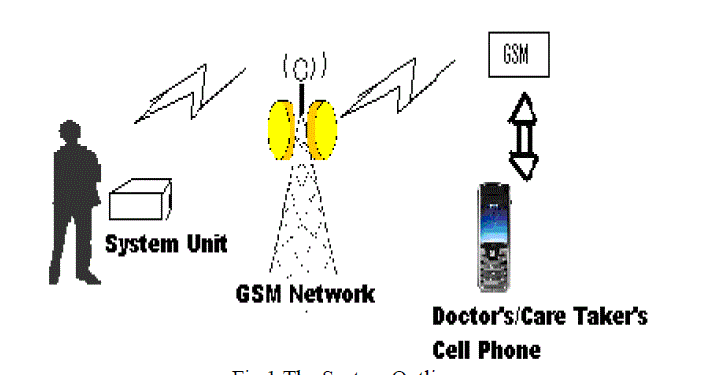 |
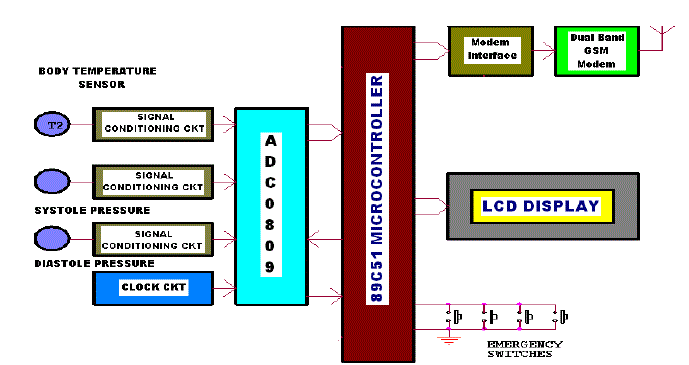 |
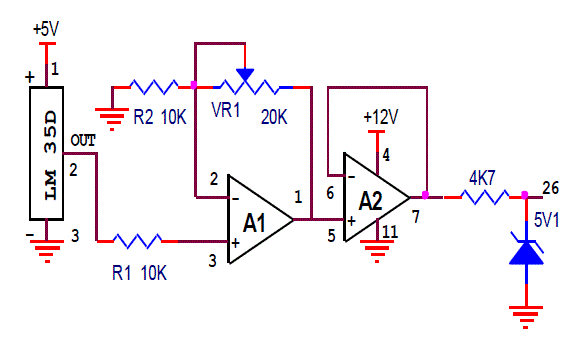 |
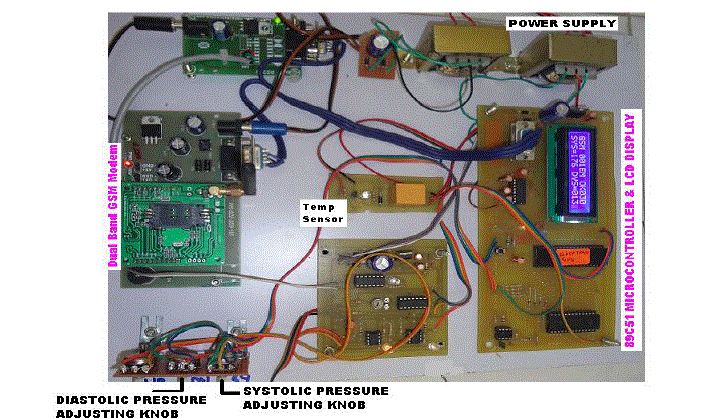 |
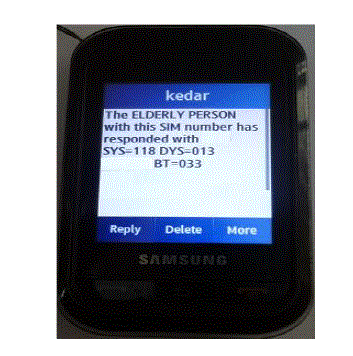 |
| Figure 1 |
Figure 2 |
Figure 3 |
Figure 4 |
Figure 5 |
|
References
|
- R.G. Jamkar and R.H. Chile “Microcontroller based Temperature Indicator and Controller”, Journal of Instrument. Society of India 34(3)pp.180-186, Sept-2004.
- A.Rajendran and P. Neelamegam “Design of AT89C52 Microcontroller based system for the measurement of Temperature and control”,Journal of Instrument. Society of India 35(I) pp. 99-105, March-2005.
- J. Jayapandian and Usha Rani Ravi “An Embedded Single Chip Temperature Controller Design” Journal of Instrument Society of India38(2) pp.132-136, June-2008.
- V.S. Waydande and A.N. Jadhav “Design & Development of Wearable Cardiac Telemonitoring System” Proceeding of International Conference on Communication, Computation, Control and Nanotechnology –ICN-2010, REC, Bhalki, pp. 211-213, Oct-2010.
- B.Santhikiran., E. Vargil Vijay and M.V.H.Bhaskara Murthy “Design of Multi-Point Short Range Wireless Data Communication Systems”Proceeding of International Conference on Communication, Computation, Control and Nanotechnology –ICN-2010, REC, Bhalki, PP 266-270, Oct-2010.
- Sudhindra.F.,Vani.R.M., Annarao.S.J. and P.V.Hungund “A Short Range Wireless Enbedded System for Measurement & Control of Temperature Using Atmel’s 89C51 Microcontroller” Proceeding of International Conference on Communication, Computation, Control andNanotechnology –ICN-2010, REC, Bhalki, PP 457-460, Oct-2010.
- Reza Fazel-Rezai., Mark Pauls and David Slawinski “A Low-Cost Biomedical Signal Transceiver based on a Bluetooth Wireless system”Proceedings of the 29th Annual International Conference of the IEEE EMBS Lyon, France, pp. 5711-5714, August-2007.
- M.Harikrishna and Dr.K.PadmaRaju “GSM & GPS based System for monitoring of Elderly People” Proceeding of International Conferenceon Communication, Computation, Control and Nanotechnology –ICN-2010, REC, Bhalki, pp. 94-99, Oct-2010.
- IoanLita., Ion BogdanCioc., and Daniel AlexandruVisan “A New Approach of Automobile Localization System Using GPS and GSM/GPRSTransmission” Proceedings of IEEE, St. Marienthal, Germany, pp. 115-119 June-2006.
- Xu Meihua., Fei Yu., Zhao Fangjie and Zhu Qian “A Remote Medical Monitoring System Based on GSM Network” IET International Communication Conference on Wireless Mobile and Computing (CCWMC-2009), pp.381-384, Dec-2009.
- Aris Tanti Hapsari., Eniman Y Syamsudin and ImronPramana “Design of Vehicle Position tracking System using Short Message Services and its implementation on FPGA” IEEE, ASP-DAC 2005, pp.19-20, July-2005.
|